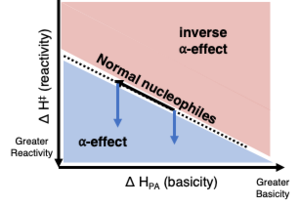Alpha effect

The alpha effect refers to the increased nucleophilicity of an atom due to the presence of an adjacent (alpha) atom with lone pair electrons.[2] This first atom does not necessarily exhibit increased basicity compared with a similar atom without an adjacent electron-donating atom, resulting in a deviation from the classical Brønsted-type reactivity-basicity relationship. In other words, the alpha effect refers to nucleophiles presenting higher nucleophilicity than the predicted value obtained from the Brønsted basicity. The representative examples would be high nucleophilicities of hydroperoxide (HO2−) and hydrazine (N2H4).[3] The effect is now well established with numerous examples and became an important concept in mechanistic chemistry and biochemistry.[4] However, the origin of the effect is still controversial without a clear winner.
Background
[edit]Experiment
[edit]The effect was first observed by Jencks and Carriuolo in 1960[5][6] in a series of chemical kinetics experiments involving the reaction of the ester p-nitrophenyl acetate with a range of nucleophiles. Regular nucleophiles such as the fluoride anion, aniline, pyridine, ethylene diamine and the phenolate ion were found to have pseudo first order reaction rates corresponding to their basicity as measured by their pKa. Other nucleophiles however reacted much faster than expected based on this criterion alone. These include hydrazine, hydroxylamine, the hypochlorite ion and the hydroperoxide anion.
α -effect
[edit]In 1962, Edwards and Pearson (the latter of HSAB theory) introduced the phrase alpha effect for this anomaly. He offered the suggestion that the effect was caused by a transition state (TS) stabilization effect: on entering the TS the free electron pair on the nucleophile moves away from the nucleus, causing a partial positive charge which can be stabilized by an adjacent lone pair as for instance happens in any carbocation.[7]
Theory
[edit]Over the years, many additional theories have been put forward attempting to explain the effect.
Ground state destabilization
[edit]The ground state destabilization theory proposes that the electron-electron repulsion between the alpha lone-pair and nucleophilic electron pair destabilize each other by electronic repulsion (filled–filled orbital interaction) thereby decreasing the activation barrier by increasing the ground state energy and making it more reactive. This explains the higher reactivity of
Transition state stabilization
[edit]Many explanations fall into this category. First, the secondary orbital interactions theory emphasized that electron-donating heteroatom in the
Thermodynamic product stability
[edit]This explanation proposes that a stable product could contribute to the alpha effect, however, this factor could not be the sole factor.[4]
Solvent-induced effects
[edit]The alpha effect is also dependent on solvent but not in a predictable way: it can increase or decrease with solvent mix composition or even go through a maximum.[12] At least in some cases, the alpha effect has been observed to vanish if the reaction is conducted in the gas phase, leading some to conclude that it is primarily a solvation effect.[13] However, this explanation has limitations since similar alpha effects could be found in different solvent systems and also because the solvation affects both the basicity and the nucleophilicity of the nucleophile.[4]
Pauli repulsion and HOMO-LUMO overlap
[edit]
In the recent article published in 2021,[14] Hansen and Vermeeren proposed the two requirements for an

First, the
To elaborate on the first requirement, the electronegative heteroatom reduces the electron density of the atom that attacks the nucleophile making the HOMO lobe smaller. This minimizes the Pauli repulsion between the substrate and the nucleophile. Nonetheless, these small HOMO lobes don't mean less orbital interaction than the parent normal nucleophile. This is because
Examples of

Examples of

See also
[edit]References
[edit]- ^ a b c d e Hansen, Thomas; Vermeeren, Pascal; Bickelhaupt, F. Matthias; Hamlin, Trevor A. (2021-07-26). "Origin of the
α -Effect in SN2 Reactions". Angewandte Chemie International Edition. 60 (38): 20840–20848. doi:10.1002/anie.202106053. ISSN 1433-7851. PMC 8518820. PMID 34087047. - ^ Chemical Reactivity . 14 July 2006. Michigan State University. 27 Jul 2006 <[1]>.
- ^ Smith, Michael B.; March, Jerry (2007), Advanced Organic Chemistry: Reactions, Mechanisms, and Structure (6th ed.), New York: Wiley-Interscience, p. 495, ISBN 978-0-471-72091-1
- ^ a b c d Fina, Nick J.; Edwards, John O. (January 1973). "The alpha effect. A review". International Journal of Chemical Kinetics. 5 (1): 1–26. doi:10.1002/kin.550050102. ISSN 0538-8066.
- ^ William P. Jencks; Joan Carriuolo (1960). "Reactivity of Nucleophilic Reagents toward Esters". Journal of the American Chemical Society. 82 (7): 1778–86. doi:10.1021/ja01492a058.
- ^ William P. Jencks; Joan Carriuolo (1960). "General Base Catalysis of the Aminolysis of Phenyl Acetate". Journal of the American Chemical Society. 82 (3): 675–81. doi:10.1021/ja01488a044.
- ^ John O. Edwards; Ralph G. Pearson (1962). "The Factors Determining Nucleophilic Reactivities". Journal of the American Chemical Society. 84: 16–24. doi:10.1021/ja00860a005.
- ^ Liebman, Joel F.; Pollack, Ralph M. (September 1973). "Aromatic transition states and the .alpha. effect". The Journal of Organic Chemistry. 38 (19): 3444–3445. doi:10.1021/jo00959a059. ISSN 0022-3263.
- ^ Hoz, Shmaryahu (October 1982). "The .alpha. effect: on the origin of transition-state stabilization". The Journal of Organic Chemistry. 47 (18): 3545–3547. doi:10.1021/jo00139a033. ISSN 0022-3263.
- ^ Fountain, K. R.; Felkerson, Cassie J.; Driskell, Jeremy D.; Lamp, Brian D. (2003-03-01). "The
α -Effect in Methyl Transfers from S -Methyldibenzothiophenium Fluoroborate to Substituted N -Methylbenzohydroxamates". The Journal of Organic Chemistry. 68 (5): 1810–1814. doi:10.1021/jo0206263. ISSN 0022-3263. PMID 12608795. - ^ Ren, Y; Yamataka, H (Jul 2007). "The alpha-effect in gas-phase SN2 reactions: existence and the origin of the effect". The Journal of Organic Chemistry. 72 (15): 5660–7. doi:10.1021/jo070650m. ISSN 0022-3263. PMID 17590049.
- ^ Buncel, Erwin; Um, Ik-Hwan (2004). "The
α -effect and its modulation by solvent". Tetrahedron. 60 (36): 7801. doi:10.1016/j.tet.2004.05.006. - ^ A., Carroll, Felix (2010). Perspectives on structure and mechanism in organic chemistry (2nd ed.). Hoboken, N.J.: John Wiley. ISBN 9780470276105. OCLC 286483846.
{{cite book}}: CS1 maint: multiple names: authors list (link) - ^ Hansen, Thomas; Vermeeren, Pascal; Bickelhaupt, F. Matthias; Hamlin, Trevor A. (2021-09-13). "Origin of the
α ‐Effect in S N 2 Reactions". Angewandte Chemie International Edition. 60 (38): 20840–20848. doi:10.1002/anie.202106053. ISSN 1433-7851. PMC 8518820. PMID 34087047.
